Everything discussed in the first part of my series will lay the foundation for each subsequent coverage. If you have not read it, I encourage you to do so here.
Remember our rule from last time? The number after "Cover" points to the number of deep zones being occupied by the defense. In this case, that means Cover 3 is a three deep zone with four zone defenders underneath.
This defense was long thought to be a weak defense due to the ability to attack the zones with levels concepts, but the Seattle Seahawks rode this defense to back to back Super Bowls, including a crushing victory over the Denver Broncos in Super Bowl XLVIII.
Let us take a look at an example of how the Carolina Panthers were able to exploit the Baltimore Ravens Cover 3 defense during the Week 8 match-up. Facing 2nd and 9 from their own 2 yard line with 9:35 to go in the second quarter, the Panthers showed exactly how to beat Cover 3.
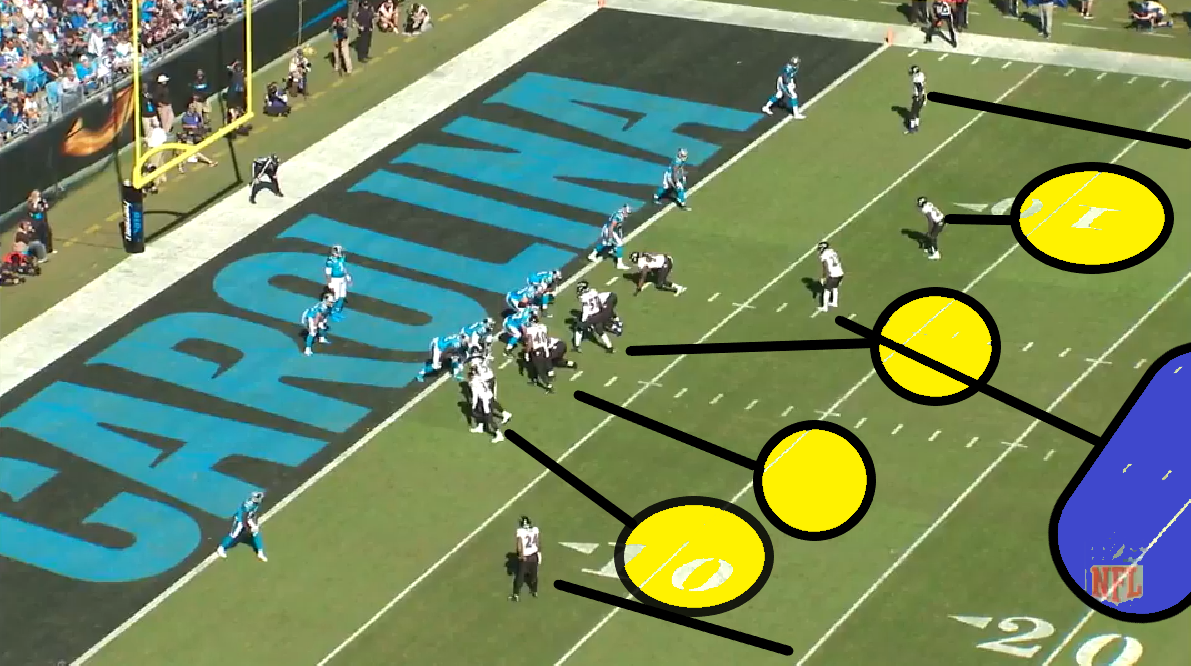
Cover 3 obviously earned its name from the three deep zone defenders, in this case, the free safety, responsible for the deep middle third, and the two outside cornerbacks, responsible for the outside thirds, will man the deep zones. Underneath, the the defense will create a four zone look with two outside curl-flat defenders, in this case, the nickel cornerback and the strong safety, and two middle hook zone defenders, the WILL and MIKE linebackers in this case.
The two outside cornerbacks have the option of playing from an off man coverage alignment or from a press man coverage alignment. Cornerbacks who align in a press man alignment will often use what is called "press-bail technique" (more on that later) to create the necessary depth of 18-20 yards downfield. The cornerbacks will carry all vertical stemming routes and will funnel all deep breaking in routes to the middle of the field toward the free safety while cushioning outside releases with the sideline.
The two curl-flat defenders will work to take away the inside curl route and drop to a depth of 10-12 yards before widening to protect the flats. The goal is to work to the top (outside) of the numbers. If there is a wheel route from the running back, slot receiver, or tight end, the curl-flat defenders must run the wheel route with the receiver. A flat defender cannot ever get out leveraged to the flat as this leaves too much open grass down the sidelines. The run/pass key for the curl-flat defenders is going to be the tight end and the weak-side tackle. Remember the high hat/low hat reads.
The middle hook defenders will drop to a depth of 10-12 yards and cushion the inside seam route while protecting against any inside breaking routes underneath of the safety. The middle hook zone defenders will read the two guards and the center for their run/pass keys.
Let us take a look at how the rest of the play unfolds.
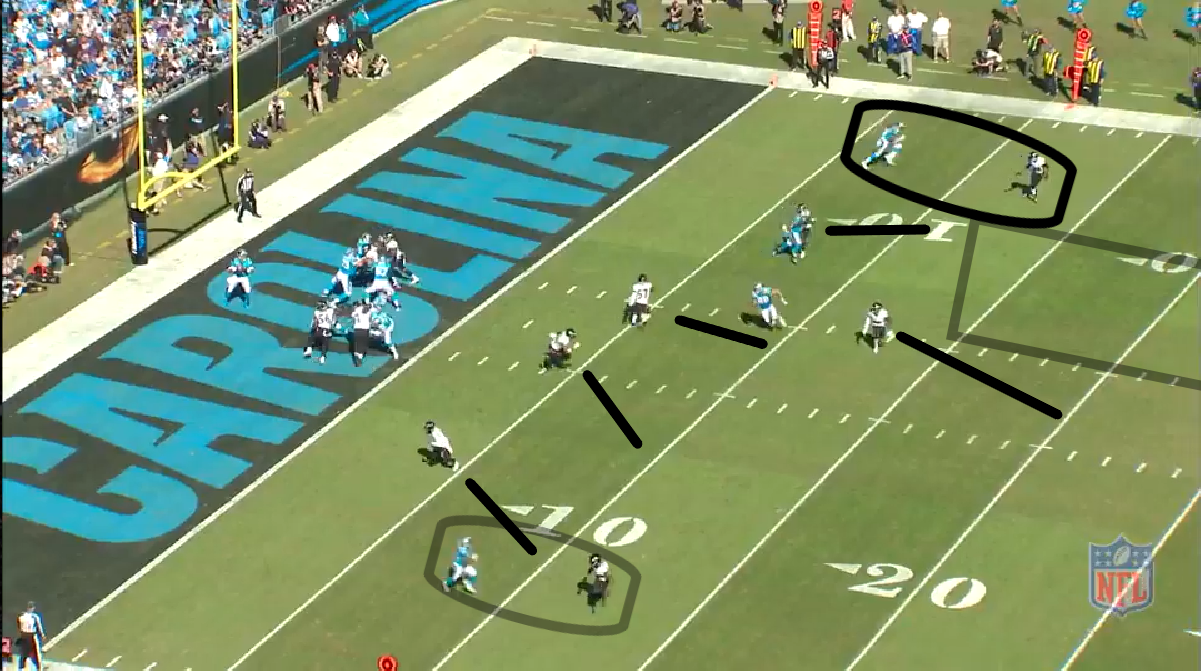
Jimmy Smith and Brandon Carr play the outside vertical routes. Both wide receivers release with an outside release, so the cornerbacks will cushion the verticals with the sideline. Jimmy Smith shows a press-bail technique. In press bail, the cornerback will show press, but "bail" at the snap and run to his deep zone with his back to the sideline. Underneath, CJ Mosley and Kenny Young drop into middle hook zones that will cushion against Greg Olsen's inside breaking route. Tavon Young cushions against DJ Moore's inside seam route (shameless plug to say that I wanted DJ Moore to be a Raven). Tony Jefferson, however, is going to open to the weak-side of the passing formation before dropping to his landmark.
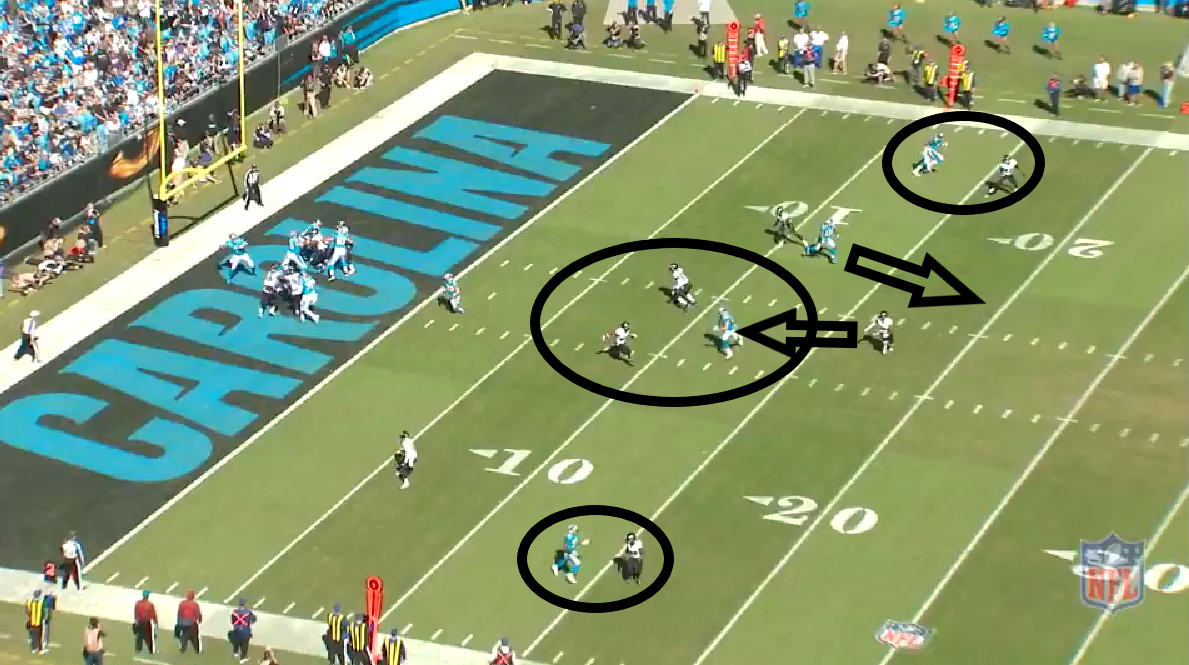
Due to Jefferson opening to the weak-side of the passing formation, he gets sucked up inside to Greg Olsen's crossing route. This means that when Tavon Young stops cushioning against the inside seam from DJ Moore, there will be nothing but open grass.
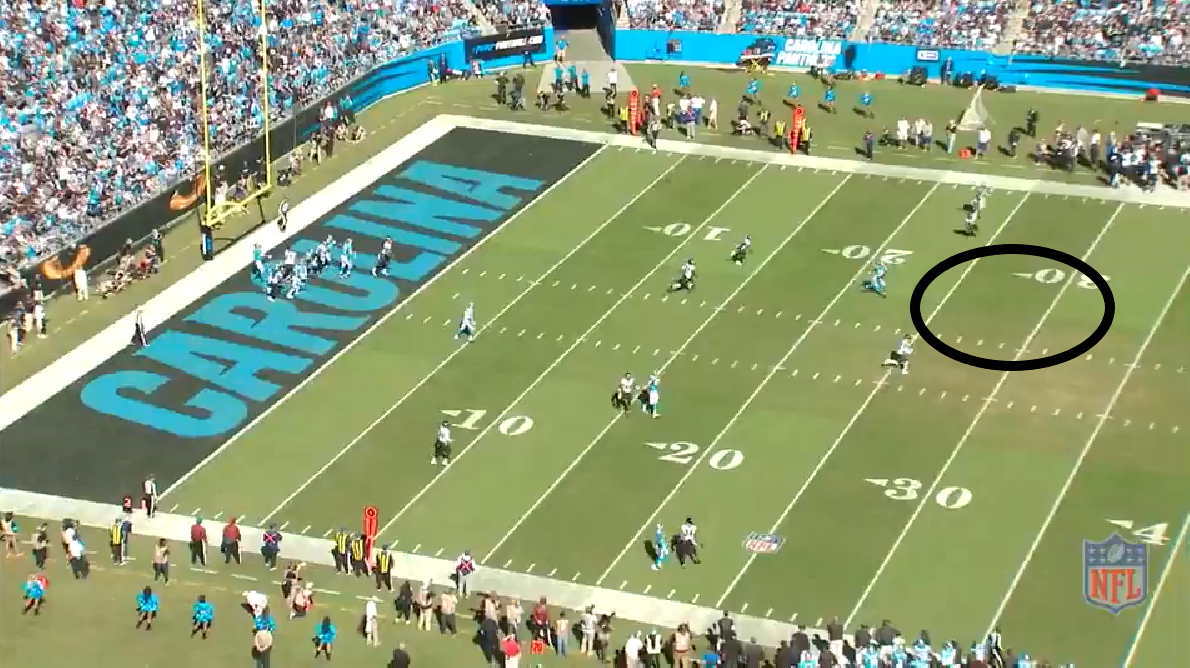
DJ Moore and Cam Newton are now playing an easy game of 7 on 7 football. The pass rush is irrelevant when a receiver has this much green grass to work with. Jefferson flips too late and Moore has an easy long completion of 33 yards.
Cover 3 vs 22 Slot Personnel
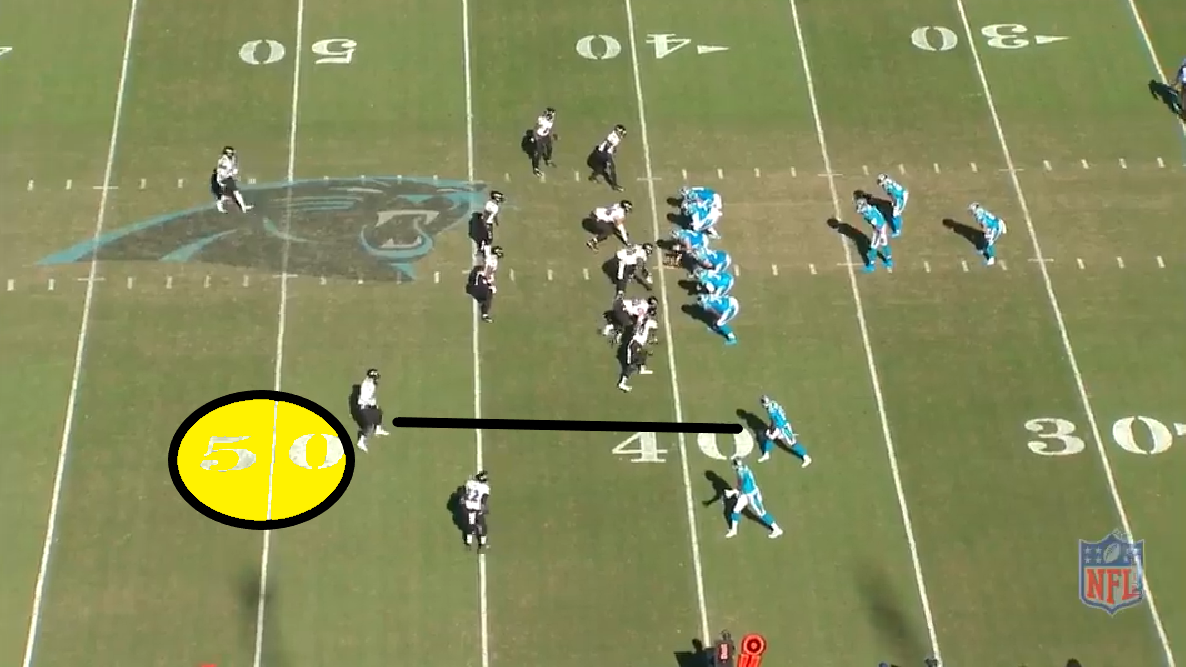
Remember, the 22 personnel refers to two tight ends and two running backs, so the offense will only have two receivers. Similar to Cover 2 zone, the cornerbacks DO NOT travel with a receiver. Instead, they will remain to one side of the formation and again drop to the deep third.
Similar to Cover 2, this will put a lot of strain on the outside cornerback who is away from the slot because he will have the job of setting the edge, which means he could be forced to block against a pulling guard. Again, buckle up that chinstrap and get low.
The main difference between Cover 2 and Cover 3 when facing the slot is that in Cover 3, the strong safety, Eric Weddle in this case, will work to reroute any vertical routes from the slot receiver to the inside and funnel them to the free safety before working his way to his curl-flat zone. He will not work over the top of the slot receiver.
The above play is from Week 13 of the 2013 season. The Ravens have the ball from their own 29 yard line with 12:23 left in the first quarter. The above is a Cover 3 "Buzz" call that showcases the versatility of the Cover 3 defenses ability to disguise its looks. Based on pre-snap alignment, this may look a lot like Cover 1 Man, and the pre-snap motion of the tight end would seem to tip this off as Troy Polamalu travels with the tight end.
However, this is obviously Cover 3, not Cover 1. The reason this is called a "Buzz" is because the strong safety will play the role of the middle hook zone defender and the SAM linebacker, in this case, will play the role of the curl-flat defender.
Cover 3 Buzz can also be used to disguise a two deep look. The strong safety can align at a depth of 15-18 yards pre-snap and "buzz" downhill to a depth of 10-12 yards and take away any middle breaking routes.
Cloud coverage refers to a unique case in Cover 3 where instead of having two deep cornerbacks occupy the outside third zones, the strong safety and a cornerback will occupy the outside third zones.
The picture more or less gets it right, except for two details. Firstly, the left cornerback will not actually work downhill; he will press the wide receiver at the line of scrimmage and force an inside release. He will then help to cushion against the vertical release of the wide receiver. Secondly, the free safety and strong safety would align in a standard two deep look and then "roll" their coverages to create the three deep look.
This is a special coverage used against wide receivers that have special deep ball ability to help put a lid over the top of the wide receiver.
For starters, the inside seams of the defense are always going to be a concern. A football field is roughly 52 yards wide and if that is divided up between three players, that means each has 14 yards to defend. However, this also assumes that the three players start deep. In reality, the cornerbacks must work to gain a depth of 18-20 yards, leaving the free safety as the sole deep defender off the snap to work with 52 yards of field.
The Panthers exploited this by sending Greg Olsen with a deep in, drawing the free safety downhill, and then slipping DJ Moore down the seams. The width of the football field and the spacing meant that the free safety never had a chance to recover.
That is the way to beat Cover 3: force the zone defenders to make a choice on who to cover and who to let go through levels concepts.
For example, if the outside wide receiver releases into a vertical route, the cornerback will carry him through the vertical. We then can exploit the curl-flat defender by sending the running back into the flat (remember, the curl-flat defender must never get out leveraged to the flat) and then send the tight end or slot receiver to a deep out route to get behind the curl-flat defender, but underneath the deep third cornerback.
For all the Madden fans out there, there is always the good ol' four verticals option. A defense cannot defend four deep routes with only three deep defenders, amirite'?
That is why it is so important to disguise the look pre-snap: to not allow the defense to audible and adjust into levels concepts that will exploit the Cover 3 call.
However, Cover 3 is still a strong defense to use that offers amazing pass/run balance for the defense.
Due to the ability to move the strong safety all over the field, the defense is not weak to the run. The defense can afford to shift the strong safety into the box without actually losing any coverage ability.
The three deep defenders also means that more "explosive" plays are limited as compared to Cover 2 because the deep defenders have less ground to cover and work over the top of.
While this defense may have formerly been viewed as soft, back to back Super Bowl appearances from the Seattle Seahawks has shown that this is not the case and has helped turn the Cover 3 defense into a staple on Sundays.
This is the fourth part in a multi-part series detailing coverages that are employed by NFL secondaries.
Part 1: Football for Dummies: Press Man Coverage vs Off Man Coverage
Part 2: Football for Dummies: Cover 1
Part 3: Football for Dummies: Cover 2
Remember our rule from last time? The number after "Cover" points to the number of deep zones being occupied by the defense. In this case, that means Cover 3 is a three deep zone with four zone defenders underneath.
This defense was long thought to be a weak defense due to the ability to attack the zones with levels concepts, but the Seattle Seahawks rode this defense to back to back Super Bowls, including a crushing victory over the Denver Broncos in Super Bowl XLVIII.
Cover 3
Cover 3 is a defense designed to put a top over the offense and try to force underneath throws to the middle of the field. This defense ideally aims to take away the deep passing game and limit gains to short, quick completions to burn the clock. However, this defense has weaknesses that can be exploited through the seams. Let us take a look at an example of how the Carolina Panthers were able to exploit the Baltimore Ravens Cover 3 defense during the Week 8 match-up. Facing 2nd and 9 from their own 2 yard line with 9:35 to go in the second quarter, the Panthers showed exactly how to beat Cover 3.

The two outside cornerbacks have the option of playing from an off man coverage alignment or from a press man coverage alignment. Cornerbacks who align in a press man alignment will often use what is called "press-bail technique" (more on that later) to create the necessary depth of 18-20 yards downfield. The cornerbacks will carry all vertical stemming routes and will funnel all deep breaking in routes to the middle of the field toward the free safety while cushioning outside releases with the sideline.
The two curl-flat defenders will work to take away the inside curl route and drop to a depth of 10-12 yards before widening to protect the flats. The goal is to work to the top (outside) of the numbers. If there is a wheel route from the running back, slot receiver, or tight end, the curl-flat defenders must run the wheel route with the receiver. A flat defender cannot ever get out leveraged to the flat as this leaves too much open grass down the sidelines. The run/pass key for the curl-flat defenders is going to be the tight end and the weak-side tackle. Remember the high hat/low hat reads.
The middle hook defenders will drop to a depth of 10-12 yards and cushion the inside seam route while protecting against any inside breaking routes underneath of the safety. The middle hook zone defenders will read the two guards and the center for their run/pass keys.
Let us take a look at how the rest of the play unfolds.

Jimmy Smith and Brandon Carr play the outside vertical routes. Both wide receivers release with an outside release, so the cornerbacks will cushion the verticals with the sideline. Jimmy Smith shows a press-bail technique. In press bail, the cornerback will show press, but "bail" at the snap and run to his deep zone with his back to the sideline. Underneath, CJ Mosley and Kenny Young drop into middle hook zones that will cushion against Greg Olsen's inside breaking route. Tavon Young cushions against DJ Moore's inside seam route (shameless plug to say that I wanted DJ Moore to be a Raven). Tony Jefferson, however, is going to open to the weak-side of the passing formation before dropping to his landmark.

Due to Jefferson opening to the weak-side of the passing formation, he gets sucked up inside to Greg Olsen's crossing route. This means that when Tavon Young stops cushioning against the inside seam from DJ Moore, there will be nothing but open grass.

DJ Moore and Cam Newton are now playing an easy game of 7 on 7 football. The pass rush is irrelevant when a receiver has this much green grass to work with. Jefferson flips too late and Moore has an easy long completion of 33 yards.
Cover 3 vs 22 Slot Personnel

Similar to Cover 2, this will put a lot of strain on the outside cornerback who is away from the slot because he will have the job of setting the edge, which means he could be forced to block against a pulling guard. Again, buckle up that chinstrap and get low.
The main difference between Cover 2 and Cover 3 when facing the slot is that in Cover 3, the strong safety, Eric Weddle in this case, will work to reroute any vertical routes from the slot receiver to the inside and funnel them to the free safety before working his way to his curl-flat zone. He will not work over the top of the slot receiver.
Cover 3 Buzz
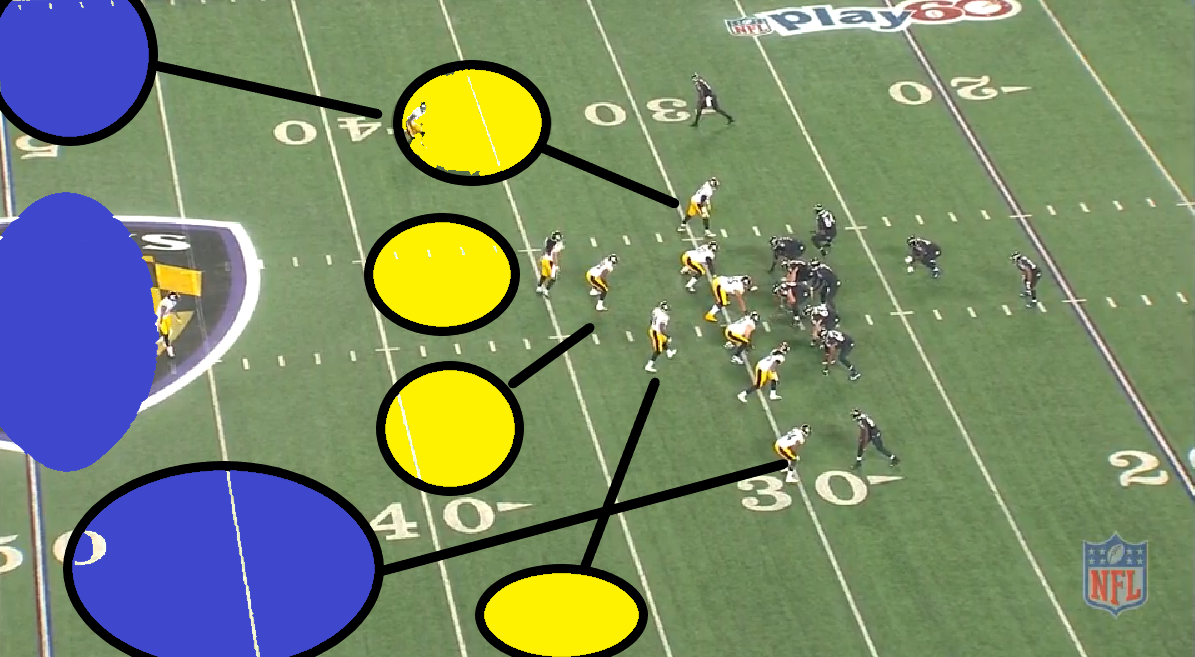
Cover 3 offers its own flexibility and ability to disguise its looks through the strong safety. The strong safety is an absolute chess piece in Cover 3. 
The above play is from Week 13 of the 2013 season. The Ravens have the ball from their own 29 yard line with 12:23 left in the first quarter. The above is a Cover 3 "Buzz" call that showcases the versatility of the Cover 3 defenses ability to disguise its looks. Based on pre-snap alignment, this may look a lot like Cover 1 Man, and the pre-snap motion of the tight end would seem to tip this off as Troy Polamalu travels with the tight end.
However, this is obviously Cover 3, not Cover 1. The reason this is called a "Buzz" is because the strong safety will play the role of the middle hook zone defender and the SAM linebacker, in this case, will play the role of the curl-flat defender.
Cover 3 Buzz can also be used to disguise a two deep look. The strong safety can align at a depth of 15-18 yards pre-snap and "buzz" downhill to a depth of 10-12 yards and take away any middle breaking routes.
Cover 3 Cloud
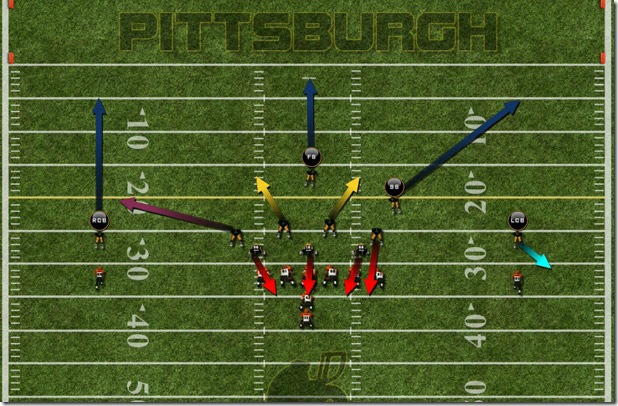
I apologize for the poor quality madden photo, but this is not a very easy play to find on the fly.
Cloud coverage refers to a unique case in Cover 3 where instead of having two deep cornerbacks occupy the outside third zones, the strong safety and a cornerback will occupy the outside third zones.
The picture more or less gets it right, except for two details. Firstly, the left cornerback will not actually work downhill; he will press the wide receiver at the line of scrimmage and force an inside release. He will then help to cushion against the vertical release of the wide receiver. Secondly, the free safety and strong safety would align in a standard two deep look and then "roll" their coverages to create the three deep look.
This is a special coverage used against wide receivers that have special deep ball ability to help put a lid over the top of the wide receiver.
The Strengths and Weaknesses of Cover 3
At the top of the article, I talked about how this defense was once viewed as weak due to the ability to attack specific vulnerabilities within the Cover 3 zones. To start off, I showed a perfect example of how the Panthers were able to exploit the Ravens Cover 3 defense using a simple levels concept.For starters, the inside seams of the defense are always going to be a concern. A football field is roughly 52 yards wide and if that is divided up between three players, that means each has 14 yards to defend. However, this also assumes that the three players start deep. In reality, the cornerbacks must work to gain a depth of 18-20 yards, leaving the free safety as the sole deep defender off the snap to work with 52 yards of field.
The Panthers exploited this by sending Greg Olsen with a deep in, drawing the free safety downhill, and then slipping DJ Moore down the seams. The width of the football field and the spacing meant that the free safety never had a chance to recover.
That is the way to beat Cover 3: force the zone defenders to make a choice on who to cover and who to let go through levels concepts.
For example, if the outside wide receiver releases into a vertical route, the cornerback will carry him through the vertical. We then can exploit the curl-flat defender by sending the running back into the flat (remember, the curl-flat defender must never get out leveraged to the flat) and then send the tight end or slot receiver to a deep out route to get behind the curl-flat defender, but underneath the deep third cornerback.
For all the Madden fans out there, there is always the good ol' four verticals option. A defense cannot defend four deep routes with only three deep defenders, amirite'?
That is why it is so important to disguise the look pre-snap: to not allow the defense to audible and adjust into levels concepts that will exploit the Cover 3 call.
However, Cover 3 is still a strong defense to use that offers amazing pass/run balance for the defense.
Due to the ability to move the strong safety all over the field, the defense is not weak to the run. The defense can afford to shift the strong safety into the box without actually losing any coverage ability.
The three deep defenders also means that more "explosive" plays are limited as compared to Cover 2 because the deep defenders have less ground to cover and work over the top of.
While this defense may have formerly been viewed as soft, back to back Super Bowl appearances from the Seattle Seahawks has shown that this is not the case and has helped turn the Cover 3 defense into a staple on Sundays.
This is the fourth part in a multi-part series detailing coverages that are employed by NFL secondaries.
Part 1: Football for Dummies: Press Man Coverage vs Off Man Coverage
Part 2: Football for Dummies: Cover 1
Part 3: Football for Dummies: Cover 2

